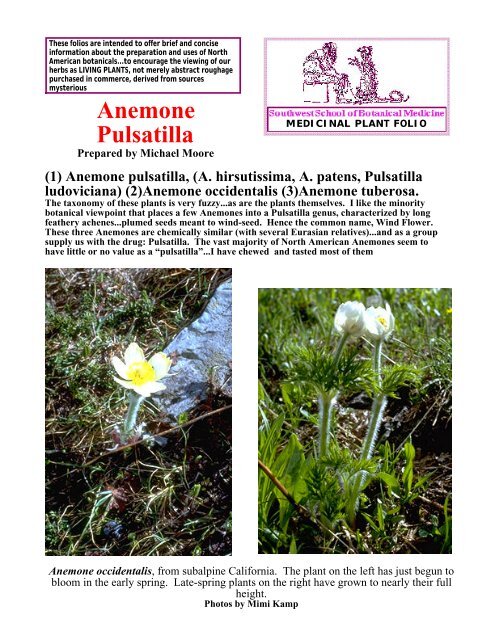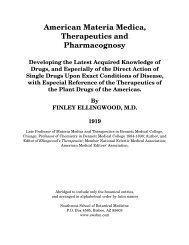Anemone pulsatilla Folio - Southwest School of Botanical Medicine
Anemone pulsatilla Folio - Southwest School of Botanical Medicine
Anemone pulsatilla Folio - Southwest School of Botanical Medicine
Create successful ePaper yourself
Turn your PDF publications into a flip-book with our unique Google optimized e-Paper software.
These folios are intended to <strong>of</strong>fer brief and concise<br />
information about the preparation and uses <strong>of</strong> North<br />
American botanicals...to encourage the viewing <strong>of</strong> our<br />
herbs as LIVING PLANTS, not merely abstract roughage<br />
purchased in commerce, derived from sources<br />
mysterious<br />
<strong>Anemone</strong><br />
Pulsatilla<br />
Prepared by Michael Moore<br />
MEDICINAL PLANT FOLIO<br />
(1) <strong>Anemone</strong> <strong>pulsatilla</strong>, (A. hirsutissima, A. patens, Pulsatilla<br />
ludoviciana) (2)<strong>Anemone</strong> occidentalis (3)<strong>Anemone</strong> tuberosa.<br />
The taxonomy <strong>of</strong> these plants is very fuzzy...as are the plants themselves. I like the minority<br />
botanical viewpoint that places a few <strong>Anemone</strong>s into a Pulsatilla genus, characterized by long<br />
feathery achenes...plumed seeds meant to wind-seed. Hence the common name, Wind Flower.<br />
These three <strong>Anemone</strong>s are chemically similar (with several Eurasian relatives)...and as a group<br />
supply us with the drug: Pulsatilla. The vast majority <strong>of</strong> North American <strong>Anemone</strong>s seem to<br />
have little or no value as a “<strong>pulsatilla</strong>”...I have chewed and tasted most <strong>of</strong> them<br />
<strong>Anemone</strong> occidentalis, from subalpine California. The plant on the left has just begun to<br />
bloom in the early spring. Late-spring plants on the right have grown to nearly their full<br />
height.<br />
Photos by Mimi Kamp
PLANT PART............ FRESH HERB-from spring flowering to early seeding.<br />
PREPARATION:<br />
•Tincture <strong>of</strong> the fresh plant [1:2]. Despite many references to the contrary, ONLY the<br />
fresh plant is potent.<br />
DOSAGE: 3-10 drops, to 4X a day. USE WITH CARE.<br />
NOTE: The medicine works quickly...the active constituents are camphor-like and acrid,<br />
similar to those found in such relatives as the Buttercups. Its absorption is quick, effecting the<br />
central nervous system almost immediately, rather that the usual pattern <strong>of</strong> gradual<br />
absorption from the intestinal, through the liver, thence into general circulation.<br />
Several drops on the tongue or with a little water is the appropriate dose. Larger amounts<br />
wont help if smaller ones don’t. It simply means the herb is inappropriate, Large amounts<br />
(usually over 30 drops) may produce strong effects on the autonomic nervous system, with a<br />
sense <strong>of</strong> cold, a clammy sweat and even dizziness...the small doses produce NO side effects.<br />
This dichotomy may seem peculiar, but a LITTLE Pulsatilla effects the brain only...large<br />
doses are absorbed in general circulation and produce a predominantly somatic response<br />
<strong>Anemone</strong> patens (also called A. <strong>pulsatilla</strong>, A. hirsutissima, Pulsatilla hirsutissima<br />
and P. ludoviciana. Young spring plants in a field in the Bighorn Mountains <strong>of</strong><br />
Wyoming. The best-known <strong>of</strong> the medicinal Pulsatillas<br />
Photo by Michael Moore
<strong>Anemone</strong> tuberosa - Desert Windflower - SE Arizona<br />
Thicket habit<br />
Photo by Mimi Kamp<br />
SUMMARY OF USES:<br />
Insomnia, nervousness, and a generally agitated emotional state with gloom and<br />
distress. Wan and chilly, not hot and flushed.<br />
CONTRAINDICATIONS:<br />
Pregnancy, bradycardia, acute and febrile conditions.<br />
SPECIFIC INDICATIONS:<br />
•Increased intraocular pressure; lachrymitis; glaucoma in aged or tired; viral iritis; fullblown<br />
styes on lids; ophthalmalgia;<br />
•Eyestrain with orbital pain; conjunctivitis, watery and inflamed with grainy vision.<br />
•Tongue white coated with nausea, or creamy white¸ with taste <strong>of</strong> rancid fats.<br />
•Otitis media; tinnitis.<br />
•Dry cough, hectic, with mucus vomiting, gagging, no overt disease.<br />
•Delirium tremens in asthenics.<br />
•To prevent anxieties when insomnia is feared.<br />
•Incontinence from chronic nephritis or acute lower urinary tract infections.<br />
•Amenorrhea with depressions.<br />
•Dysmenorrhea, with depressions and lengthy history <strong>of</strong> PMS.<br />
•Impotence/frigidity, from constant anxiety and depression regarding sexuality with fear<br />
<strong>of</strong> no arousal, lubrication or erection.<br />
•Leukorrhea; hypersecretory, milky, little smell.<br />
•Orchitis/epididymitis, with red, enlarged and painful testicles, no major pathology.<br />
•Lactation, suppressed from nervousness, mild sympathetic excess, with painful, swollen<br />
breasts.<br />
•Depression with nervous irritation.<br />
•Hysteria, in depressive states.<br />
•Migraine headaches, as a vasodilator.<br />
•Dopamine/prolactin antagonist, for in PMS symptoms from a short progesterone phase<br />
•Minor symptoms derived from elevated cerebrospinal fluid pressure and caused by<br />
catecholamine excess; PMS (see previous), orbital headaches, some neck pain.
<strong>Anemone</strong> tuberosa - Desert Windflower - SE Arizona<br />
Open rocky habit<br />
Photo by Mimi Kamp<br />
SOUTHWEST SCHOOL OF BOTANICAL MEDICINE<br />
PO Box 4565, Bisbee, AZ 85603<br />
E-Mail hrbmoore@mindspring.com<br />
WWW: http://www.swsbm.com
















